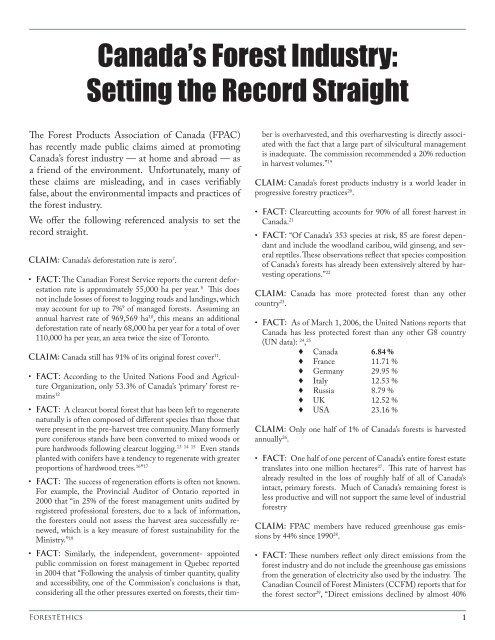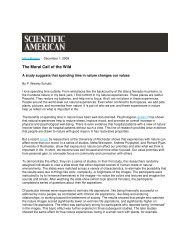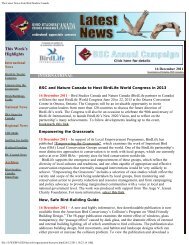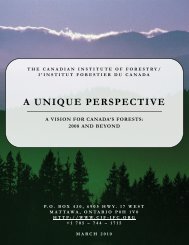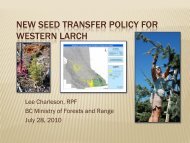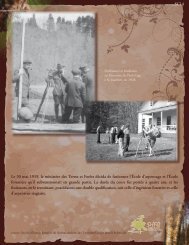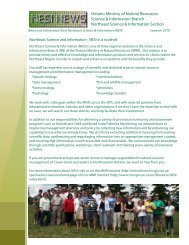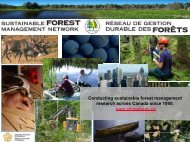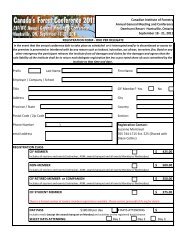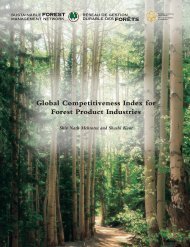Canada's Forest Industry: Setting the Record Straight - Canadian ...
Canada's Forest Industry: Setting the Record Straight - Canadian ...
Canada's Forest Industry: Setting the Record Straight - Canadian ...
Create successful ePaper yourself
Turn your PDF publications into a flip-book with our unique Google optimized e-Paper software.
Canada’s <strong>Forest</strong> <strong>Industry</strong>:<strong>Setting</strong> <strong>the</strong> <strong>Record</strong> <strong>Straight</strong>The <strong>Forest</strong> Products Association of Canada (FPAC)has recently made public claims aimed at promotingCanada’s forest industry — at home and abroad — asa friend of <strong>the</strong> environment. Unfortunately, many of<strong>the</strong>se claims are misleading, and in cases verifiablyfalse, about <strong>the</strong> environmental impacts and practices of<strong>the</strong> forest industry.We offer <strong>the</strong> following referenced analysis to set <strong>the</strong>record straight.CLAIM: Canada’s deforestation rate is zero 7 .• FACT: The <strong>Canadian</strong> <strong>Forest</strong> Service reports <strong>the</strong> current deforestationrate is approximately 55,000 ha per year. 8 This doesnot include losses of forest to logging roads and landings, whichmay account for up to 7% 9 of managed forests. Assuming anannual harvest rate of 969,569 ha 10 , this means an additionaldeforestation rate of nearly 68,000 ha per year for a total of over110,000 ha per year, an area twice <strong>the</strong> size of Toronto.CLAIM: Canada still has 91% of its original forest cover 11 .• FACT: According to <strong>the</strong> United Nations Food and AgricultureOrganization, only 53.3% of Canada’s ‘primary’ forest remains12• FACT: A clearcut boreal forest that has been left to regeneratenaturally is often composed of different species than those thatwere present in <strong>the</strong> pre-harvest tree community. Many formerlypure coniferous stands have been converted to mixed woods orpure hardwoods following clearcut logging. 13 14 15 Even standsplanted with conifers have a tendency to regenerate with greaterproportions of hardwood trees. 16 ” 17• FACT: The success of regeneration efforts is often not known.For example, <strong>the</strong> Provincial Auditor of Ontario reported in2000 that “in 25% of <strong>the</strong> forest management units audited byregistered professional foresters, due to a lack of information,<strong>the</strong> foresters could not assess <strong>the</strong> harvest area successfully renewed,which is a key measure of forest sustainability for <strong>the</strong>Ministry.” 18• FACT: Similarly, <strong>the</strong> independent, government- appointedpublic commission on forest management in Quebec reportedin 2004 that “Following <strong>the</strong> analysis of timber quantity, qualityand accessibility, one of <strong>the</strong> Commission's conclusions is that,considering all <strong>the</strong> o<strong>the</strong>r pressures exerted on forests, <strong>the</strong>ir timberis overharvested, and this overharvesting is directly associatedwith <strong>the</strong> fact that a large part of silvicultural managementis inadequate. The commission recommended a 20% reductionin harvest volumes.” 19CLAIM: Canada’s forest products industry is a world leader inprogressive forestry practices 20 .• FACT: Clearcutting accounts for 90% of all forest harvest inCanada. 21• FACT: “Of Canada’s 353 species at risk, 85 are forest dependantand include <strong>the</strong> woodland caribou, wild ginseng, and severalreptiles. These observations reflect that species compositionof Canada’s forests has already been extensively altered by harvestingoperations.” 22CLAIM: Canada has more protected forest than any o<strong>the</strong>rcountry 23 .• FACT: As of March 1, 2006, <strong>the</strong> United Nations reports thatCanada has less protected forest than any o<strong>the</strong>r G8 country(UN data): 24 , 25♦ Canada 6.84 %♦ France 11.71 %♦ Germany 29.95 %♦ Italy 12.53 %♦ Russia 8.79 %♦ UK 12.52 %♦ USA 23.16 %CLAIM: Only one half of 1% of Canada’s forests is harvestedannually 26 .• FACT: One half of one percent of Canada’s entire forest estatetranslates into one million hectares 27 . This rate of harvest hasalready resulted in <strong>the</strong> loss of roughly half of all of Canada’sintact, primary forests. Much of Canada’s remaining forest isless productive and will not support <strong>the</strong> same level of industrialforestryCLAIM: FPAC members have reduced greenhouse gas emissionsby 44% since 1990 28 .• FACT: These numbers reflect only direct emissions from <strong>the</strong>forest industry and do not include <strong>the</strong> greenhouse gas emissionsfrom <strong>the</strong> generation of electricity also used by <strong>the</strong> industry. The<strong>Canadian</strong> Council of <strong>Forest</strong> Ministers (CCFM) reports that for<strong>the</strong> forest sector 29 , “Direct emissions declined by almost 40%<strong>Forest</strong>Ethics
over <strong>the</strong> study period [1980-2002] mainly because of large reductionsin <strong>the</strong> use of refined petroleum products. At <strong>the</strong> sametime, <strong>the</strong> sector’s indirect emissions from fossil fuel electricityalmost doubled mainly because electricity was <strong>the</strong> fastest growingenergy source for <strong>the</strong> sector.” 30• FACT: The CCFM continues, “Although <strong>the</strong>re was significantvariability over <strong>the</strong> study period, <strong>the</strong> forest sector’s GHG emissionsin 2002 were unchanged from 1980, despite a 23% increasein energy use (Figure 4.1g).” 31CLAIM: “The continual improvement of sustainable forest managementpractices ensures carbon sequestration through reforestation.”32• FACT: Primary, unlogged forests store significantly more carbonthan managed forests. For example, managed boreal forest,BC Interior forest and BC coastal forest are estimated to store12.1%, 25.1% and 50.6% less carbon than primary forests in<strong>the</strong>se regions. 33 O<strong>the</strong>r estimates are in <strong>the</strong> range of 25-50%increased carbon storage in natural forests. 34CLAIM: “The development of energy-efficient production facilitiesthat run on new, clean and renewable bio-energy are madefrom wood waste instead of fossil fuels.” 35• FACT: The forest sector remains <strong>the</strong> “largest single industrialenergy user in Canada and has significant GHG emissions.” 36To its credit, <strong>the</strong> forest sector has increased energy efficiency,slightly reduced its reliance on fossil fuels and substantially increasedits use of ‘emission-free energy sources’. 37CLAIM: Numbers used by environmental groups related to emissionsfrom logging are misleading. For example, FPAC has said:• “Environmental campaigners take into account only one part of<strong>the</strong> whole carbon life cycle; and does not account for sequestrationfor example through forest regeneration.”• “All harvested forests in Canada are, by law, regenerated.”• “Carbon is also stored in products such as building materialsand furniture.”• “Accounting for carbon in forest and forest products is complexand an international process has been under way for some timeto determine how current practice might be improved.” 38• FACT: <strong>Forest</strong>Ethics has publicly communicated that loggingin Canada removes approximately 33.42 megatons of forest carbonstores every year, 39 more carbon than is emitted annuallyby all passenger vehicles in <strong>the</strong> country. 40 This number correspondsto <strong>the</strong> amount of carbon actually removed from <strong>the</strong>forest in <strong>the</strong> form of trees.• FACT: Additional carbon emissions result from <strong>the</strong> disturbanceof <strong>the</strong> soil during industrial harvesting activities. Up toeighty percent of forest carbon is stored in <strong>the</strong> soil.• FACT: Additional significant carbon emissions also resultfrom <strong>the</strong> burning of fossil fuels used to power <strong>the</strong> heavy loggingequipment and truck transport of logs and chips to mills as wellas <strong>the</strong> mills <strong>the</strong>mselves.KEY FACTS• The forest sector remains <strong>the</strong> largest single industrial energyuser in Canada and has significant GHG emissions.• Between 1980-2002 <strong>the</strong> forest sector's indirect emissionsfrom fossil fuel electricity (used by mills) almostdoubled mainly because electricity was <strong>the</strong> fastest growingenergy source for <strong>the</strong> sector. 1• Primary, unlogged forests store significantly more carbonthan logged forests. For example, logged borealforest, BC Interior forest and BC coastal forest are estimatedto store 12.1%, 25.1% and 50.6% less carbonthan primary forests in <strong>the</strong>se regions. 2• Over 110,000 hectares of forest are deforested in Canadaper year.• According to <strong>the</strong> United Nations Food and AgricultureOrganization, only 53.3% of Canada’s ‘primary’ forestremains 3 .• Clearcutting accounts for 90% of all forest harvest inCanada. 4• Canada has less protected forest than any o<strong>the</strong>r G8country at 6.84%.• Only about half of Canada’s forests remain intact, or notsubstantially modified by human activity. 5 Only 15% ofCanada’s sou<strong>the</strong>rn boreal forest remains intact and unaccessed.• One half of one percent of Canada’s forests is loggedeach year, which translates into one million hectares or2 hectares every minute 6 .• FACT: While it is true that carbon is stored in forest productslike wood and paper, <strong>the</strong>se products have a decay rate that beginsas soon as <strong>the</strong>y are harvested. New forest products are beingadded to <strong>the</strong> pool of existing forest products all <strong>the</strong> time. In<strong>the</strong> absence of reliable models to estimate <strong>the</strong> balance betweennew products being created and old ones decaying, <strong>the</strong> rulesof <strong>the</strong> Kyoto protocol assume that additions of carbon fromnew forest products merely replace losses from existing forestproducts that are decomposing (e.g. old fence posts, or last year’snewspaper). This is a responsible and reasonable assumption in<strong>the</strong> absence of sound science to prove o<strong>the</strong>rwise. Fur<strong>the</strong>rmore,studies done in both coastal rainforest in BC and Finnish borealforest show that even when counting carbon stored in forestproducts, managed forests store significantly less carbon thannatural, or unlogged, forests. 41,42CLAIM: Canada has <strong>the</strong> largest area of 3rd-party independentlycertified forests in <strong>the</strong> world (124 million hectares) 43Canada’s <strong>Forest</strong> <strong>Industry</strong>: <strong>Setting</strong> <strong>the</strong> <strong>Record</strong> <strong>Straight</strong>
• FACT: 16% of all <strong>the</strong> certified forest in Canada meets <strong>the</strong>requirements of <strong>the</strong> <strong>Forest</strong> Stewardship Council. 44 The totalamount of <strong>Canadian</strong> forest certified to FSC standards is approximately21 million hectares. 45CLAIM: 70% of Canada’s boreal is unaccessed 46 .• FACT: Global <strong>Forest</strong> Watch Canada reports that only abouthalf of Canada’s forests remain intact, showing “no signs of havingbeen substantially modified by human activity or subjectto industrial land use for <strong>the</strong> last six to seven decades.” 47 Thesou<strong>the</strong>rn and most biologically diverse forest regions in Canadahave been most affected by human activity. For example, only15% of Canada’s sou<strong>the</strong>rn boreal forest remains intact and unaccessed.CLAIM: Canada has world leading forestry practices and regulatoryregime – conclusion of an independent third party reportconducted by Dr. Benjamin Cashore, Associate Professor of Sustainable<strong>Forest</strong> Policy, and Chair of <strong>the</strong> Program on <strong>Forest</strong> Certificationat <strong>the</strong> Yale School of <strong>Forest</strong>ry and Environmental Studies.48• FACT: FPAC misrepresents <strong>the</strong> findings of Dr. Cashore’s report.In a media release responding to <strong>Canadian</strong> coverage of<strong>the</strong> report, Dr. Cashore and his co-investigator issued a “strongcaution against complacency and misinterpretation of <strong>the</strong>ir report”:49♦ “[stringency means]…<strong>the</strong> degree to which <strong>the</strong> rules includemandatory, standardized requirements for environmentalprotection…The report takes care to explain thata jurisdiction’s stringency ranking does not, by itself, sayanything about how sustainable forest policy or forest practicesmight be. It calls for future research to address <strong>the</strong>seissues.”♦ “Nowhere in <strong>the</strong> report is it stated that BC or Canada have<strong>the</strong> ‘best’ forest practices - indeed <strong>the</strong> report calls for futureresearch to look at <strong>the</strong> on-<strong>the</strong>-ground implementation andenvironmental impacts of different policy choices that governmentshave made.”• FACT: Studies by expert non-governmental organizationshave given <strong>Canadian</strong> governments poor grades on <strong>the</strong>ir protectionof environmental and social values. For example, <strong>the</strong>national average of provincial scores in World Wildlife FundCanada’s Nature Audit was 41%. 50CLAIM: “Managed forests support rich, diverse bird communities.”51• FACT: Of <strong>the</strong> 186 bird species that regularly inhabit Canada’sboreal forest, at least 40 species of land birds are experiencingpopulation declines according to long-term trends. 52CLAIM: “FPAC has been actively engaged with <strong>the</strong> federal governmenton migratory bird issues since 2000.” 53• FACT: NAFTA’s Commission for Environmental Cooperationreleased <strong>the</strong> results of a comprehensive investigation in<strong>Forest</strong>EthicsFebruary 2007 stating that it could find no evidence that that<strong>the</strong> <strong>Canadian</strong> government had enforced <strong>the</strong> Migratory BirdsAct to prevent forest companies from destroying migratory birdnests during <strong>the</strong> breeding season. The investigation also reportedthat more than 45,000 nests are probably being destroyedeach year in Ontario alone. 54CLAIM: “The boreal is relatively young” 55• FACT: The age of boreal forests is often under-estimated byconventional techniques used by <strong>the</strong> forest industry. A moreaccurate study recently carried out in <strong>the</strong> western boreal forestof Quebec found that 50% of <strong>the</strong> forest is over 100 years old. 56CLAIM: “Fires occur naturally in much of <strong>the</strong> boreal forest approximatelyevery 100 years” 57• FACT: Fire is <strong>the</strong> main natural disturbance in <strong>the</strong> boreal forest.The length of <strong>the</strong> fire cycle (i.e. <strong>the</strong> time between fires) ina given area of forest can range from between 20 to 500 years,resulting in some very old forests. 58 A well-accepted axiom inboreal forest ecology is that 37% of any given forest will be olderthan <strong>the</strong> length of <strong>the</strong> fire cycle. 59• FACT: Despite <strong>the</strong> prevalence of natural fire in <strong>the</strong> boreal forest,clearcut logging has become <strong>the</strong> primary forest disturbancein <strong>Canadian</strong> forests that are allocated for industrial forestry. 60For example, between 1951 and 1995 in Ontario, 6.6 millionhectares of forest were harvested by clearcutting, versus twomillion hectares that were burned by wildfire. 61Endnotes1 <strong>Canadian</strong> Council of <strong>Forest</strong> Ministers. 2005. Criteria and Indicators of Sustainable <strong>Forest</strong>Management in Canada. National Status 2005. Indicator 4.1.4 - <strong>Forest</strong> sector carbon emissions.2 Kurz, W.A., S.J. Beukema, M.J. Apps 1998. Carbon Budget Implications of <strong>the</strong> Transitionfrom Natural to Managed Disturbance Regimes in <strong>Forest</strong> Landscapes. Mitigation andAdaptation Strategies for Global Change 2, pp. 405-421.3 Food and Agriculture Organization (of <strong>the</strong> United Nations). 2005. Global <strong>Forest</strong> ResourceAssessment 2005 - Progress toward sustainable forest management. FAO <strong>Forest</strong>ry Paper.Rome, Italy, United Nations, Food and Agriculture Organization: pg 235, annex 3, table 9. Primary forests are defined as“forests of native species, in which <strong>the</strong>re are no clearly visible indications of human activityand ecological processes are not significantly disturbed.” (pg. 40).4 <strong>Canadian</strong> <strong>Forest</strong> Service, 2002. Compendium of <strong>Canadian</strong> <strong>Forest</strong>ry Statistics. 5 Global <strong>Forest</strong> Watch Canada. 2003. Canada’s Large Intact <strong>Forest</strong> Landscapes. 68pp.6 <strong>Forest</strong> Products Association of Canada. 2007. Sustainability Report 2007. 24pp. 7 <strong>Forest</strong> Products Association of Canada. The <strong>Canadian</strong> <strong>Forest</strong>: 10 Key Facts About Canada’s<strong>Forest</strong>s. http://www.fpac.ca/en/sustainability/forest/tenFacts.php8 Environment Canada. 2006. National Inventory Report: Greenhouse Gas Sources andSinks in Canada 1990-2004. April 2006.9 Colombo C.J., W.C. Parker, N. Lukai, Q. Dang and T. Cai. The effects of forest managementon carbon storage in Ontario’s forests (Climate change research report; CCRR-03). Ontario Ministry of Natural Resources Applied Research and Development Branch.Queens Printer for Ontario. Ontario, Canada. Pg. 82.10 <strong>Canadian</strong> Council of <strong>Forest</strong> Ministers. National <strong>Forest</strong>ry Database Program. 11 <strong>Forest</strong> Products Association of Canada. The <strong>Canadian</strong> <strong>Forest</strong>: 10 Key Facts About Canada’s<strong>Forest</strong>s. http://www.fpac.ca/en/sustainability/forest/tenFacts.php12 Food and Agriculture Organization (of <strong>the</strong> United Nations). 2005. Global <strong>Forest</strong> ResourceAssessment 2005 - Progress toward sustainable forest management. FAO <strong>Forest</strong>ry Paper.Rome, Italy, United Nations, Food and Agriculture Organization: pg 235, annex 3, table 9. Primary forests are defined as“forests of native species, in which <strong>the</strong>re are no clearly visible indications of human activityand ecological processes are not significantly disturbed.” (pg. 40).13 Hearndon, K. W., S. V. Millson and W. C. Wilson, 1992. A report on <strong>the</strong> status of forestregeneration by <strong>the</strong> Ontario Independent <strong>Forest</strong> Audit Committee. 117 In (eds), OntarioMinistry of Natural Resources. Sault St. Marie, Ontario. Queen’s Printer for Ontario
14 Carleton, T. J. and P. MacLellan, 1994. Woody vegetation responses to fire versus clear-cutlogging: A comparative survey in <strong>the</strong> Central <strong>Canadian</strong> boreal forest. Ecoscience 1: 141- 152.15 Hosie, R. C., 1953. <strong>Forest</strong> regeneration in Ontario, based on a review of surveys carried outin <strong>the</strong> Province during <strong>the</strong> period 1918 - 1951. Toronto, Ontario, University of TorontoPress. 134 p. pp.16 Hearndon, K. W., S. V. Millson and W. C. Wilson, 1992. A report on <strong>the</strong> status of forestregeneration by <strong>the</strong> Ontario Independent <strong>Forest</strong> Audit Committee. 117 In (eds), OntarioMinistry of Natural Resources. Sault St. Marie, Ontario. pp. Queen’s Printer for Ontario17 Park, A., C. Henschel, B. Kuttner, G. McEachern. 2005. A Cut Above: A Look at Alternativesto Clearcutting in <strong>the</strong> Boreal <strong>Forest</strong>. 18 Auditor General of Ontario. 2000. Special Report: Accountability and Value for Money:Ministry of Natural Resources, <strong>Forest</strong> Management Program. pg. 222. 19 Commission for <strong>the</strong> study of public forest management in Quebec. 2004. Final ReportSummary. December 2004. pg. 5. http://www.mrnfp.gouv.qc.ca/commission-foret/rapportfinal/Report_Summary.pdf20 <strong>Forest</strong> Products Association of Canada. Talking Points: Migratory Birds. April 2007.21 <strong>Canadian</strong> <strong>Forest</strong> Service, 2002. Compendium of <strong>Canadian</strong> <strong>Forest</strong>ry Statistics. 22 McRae, D. J., L. C. Duchesne, B. Freedman, T. J. Lynham and S. Woodley, 2001. Comparisonsbetween wildfire and forest harvesting and <strong>the</strong>ir implications in forest management.Environmental Reviews 9: 223-260.23 <strong>Forest</strong> Products Association of Canada. The <strong>Canadian</strong> <strong>Forest</strong>: 10 Key Facts About Canada’s<strong>Forest</strong>s. http://www.fpac.ca/en/sustainability/forest/tenFacts.php24 According to <strong>the</strong> UN Environment Programme’s World Database on Protected Areas.. (Choose region)25 The <strong>Canadian</strong> government reports that 9% of Canada is protected, but due to differences inreporting between countries, this number does not allow for an international comparison.26 <strong>Forest</strong> Products Association of Canada. The <strong>Canadian</strong> <strong>Forest</strong>: 10 Key Facts About Canada’s<strong>Forest</strong>s. http://www.fpac.ca/en/sustainability/forest/tenFacts.php27 <strong>Forest</strong> Products Association of Canada. 2007. Sustainability Report 2007. 24pp. 28 <strong>Forest</strong> Products Association of Canada. The <strong>Canadian</strong> <strong>Forest</strong>: 10 Key Facts About Canada’s<strong>Forest</strong>s. http://www.fpac.ca/en/sustainability/forest/tenFacts.php29 The forest sector includes forestry and logging, pulp and paper manufacturing, and woodproducts manufacturing.30 <strong>Canadian</strong> Council of <strong>Forest</strong> Ministers. 2005. Criteria and Indicators of Sustainable <strong>Forest</strong>Management in Canada. National Status 2005. Indicator 4.1.4 - <strong>Forest</strong> sector carbon emissions.31 <strong>Canadian</strong> Council of <strong>Forest</strong> Ministers. 2005. Criteria and Indicators of Sustainable <strong>Forest</strong>Management in Canada. National Status 2005. Indicator 4.1.4 - <strong>Forest</strong> sector carbon emissions.32 <strong>Forest</strong> Products Association of Canada. Talking Points: Climate Change and Boreal. April2007.33 Kurz, W.A., S.J. Beukema, M.J. Apps 1998. Carbon Budget Implications of <strong>the</strong> Transitionfrom Natural to Managed Disturbance Regimes in <strong>Forest</strong> Landscapes. Mitigation andAdaptation Strategies for Global Change 2, pp. 405-421.34 Cooper 1983, Harmon et al. 1990, Karjalainen 1996 as cited in Colombo C.J., W.C. Parker,N. Lukai, Q. Dang and T. Cai. The effects of forest management on carbon storage inOntario’s forests (Climate change research report; CCRR-03). Ontario Ministry of NaturalResources Applied Research and Development Branch. Queens Printer for Ontario.Ontario, Canada. Pg. 73.35 <strong>Forest</strong> Products Association of Canada. Talking Points: Climate Change and Boreal. April2007.36 <strong>Canadian</strong> Council of <strong>Forest</strong> Ministers. 2005. Criteria and Indicators of Sustainable <strong>Forest</strong>Management in Canada. National Status 2005. Indicator 4.1.4 - <strong>Forest</strong> sector carbon emissions.37 <strong>Canadian</strong> Council of <strong>Forest</strong> Ministers. 2005. Criteria and Indicators of Sustainable <strong>Forest</strong>Management in Canada. National Status 2005. Indicator 4.1.4 - <strong>Forest</strong> sector carbon emissions.38 <strong>Forest</strong> Products Association of Canada. Talking Points: Climate Change and Boreal. April2007.39 Taken from my draft “They Said We Said” fact sheet for <strong>Forest</strong> Ethics40 Environment Canada. 2006. National Inventory Report: Greenhouse Gas Sources andSinks in Canada 1990-2004. Submission to <strong>the</strong> United Nations Framework Conventionon Climate Change. April 2006 Advance Copy. Logging in Canada releases on average33 Mt of carbon (122 Mt CO2) into <strong>the</strong> atmosphere each year, which is equivalent to 16percent of Canada’s total GHG emissions. According to current IPCC 2003 methodology,emissions from forest management comprise all <strong>the</strong> CO2-C contained in harvestedroundwood and harvest residues. All carbon transferred out of managed forests as woodproducts is deemed an immediate emission. All light duty cars, trucks & motorcycles runningon gasoline, diesel, propane and natural gas combined release 96 Mt CO2.41 Harmon, M.E., Bible, K., Ryan, M.G., Shaw, D.C., Chen, H., Klopatek, J. and Li, X. 2004.“Production, Respiration, and Overall Carbon Balance in an Old-growth Pseudotsuga-Tsuga <strong>Forest</strong> Ecosystem.” Ecosystems. 7: 498-512.42 Karjalainen, T. 1996. Dynamics and potentials of carbon sequestration in managed standsand wood products in Finland under changing climatic conditions. <strong>Forest</strong> Ecology andManagement. 80: 113-132.43 <strong>Forest</strong> Products Association of Canada. 2007. Sustainability Report 2007. 24pp. 44 http://www.certificationcanada.org/english/status_intentions/canada.php [accessed Feb15, 2007].45 http://www.fsccanada.org/FSCquickfacts.htm46 <strong>Forest</strong> Products Association of Canada. The <strong>Canadian</strong> <strong>Forest</strong>: 10 Key Facts About Canada’s<strong>Forest</strong>s. http://www.fpac.ca/en/sustainability/forest/tenFacts.php47 Global <strong>Forest</strong> Watch Canada. 2003. Canada’s Large Intact <strong>Forest</strong> Landscapes. 68pp.48 <strong>Forest</strong> Products Association of Canada. The <strong>Canadian</strong> <strong>Forest</strong>: 10 Key Facts About Canada’s<strong>Forest</strong>s. http://www.fpac.ca/en/sustainability/forest/tenFacts.php49 International <strong>Forest</strong> Resources. Authors issue strong caution against complacency and misinterpretationof report. International <strong>Forest</strong> Resources and Yale Professor Ben CashoreRespond to <strong>Canadian</strong> Media Coverage on Global <strong>Forest</strong> Policy Comparison report. MediaRelease. August 1, 2004. [AccessedFeb 15, 2007]50 See World Wildlife Fund Nature Audit – <strong>Forest</strong>ry Footprint Overview of Assessment ResultsPrepared by ArborVitae Environmental Services Ltd. March 18, 2003. See also WorldWildlife Fund Canada. The Nature Audit. Available at: . See alsoan updated assessment for Quebec, Ontario, British Columbia and <strong>the</strong> FSC National BorealStandard prepared by <strong>the</strong> <strong>Canadian</strong> Parks and Wilderness Society and World WildlifeFund Canada: .51 <strong>Forest</strong> Products Association of Canada. Talking Points: Migratory Birds. April 2007.52 P. Blancher. 2003. Importance of Canada’s Boreal <strong>Forest</strong> to Landbirds. Bird Studies Canada.May, 2003. http://www.borealbirds.org/bsi-bscsummary.pdf. 41pp.53 <strong>Forest</strong> Products Association of Canada. Talking Points: Migratory Birds. April 2007.54 Commission for Environmental Cooperation. 2006. Factual <strong>Record</strong>: Ontario LoggingSubmission (SEM-02-001) & Ontario Logging II Submission (SEM-04-006). Preparedin Accordance with Article 15of <strong>the</strong> North American Agreement on Environmental Cooperation.June 2006. http://www.cec.org/files/pdf/sem/SEM-02-001-SEM-04-006-FR_en.pdf#nameddest=closing. See also http://www.cec.org/news/details/index.cfm?varlan=english&ID=2746.55 <strong>Forest</strong> Products Association of Canada. Talking Points: Migratory Birds. April 2007.56 Bergeron, Y., Leduc, A., Harvey, B.D. & Gauthier, S. 2002. Natural fire regime: a guide forsustainable management of <strong>the</strong> <strong>Canadian</strong> boreal forest. Silva Fennica 36(1): 81–95.57 <strong>Forest</strong> Products Association of Canada. <strong>Forest</strong> Products <strong>Industry</strong> Responds to Statementby <strong>Forest</strong> Ethics and Limited Brands. December 6, 2006. Ottawa. Media release. .58 McRae, D. J., L. C. Duchesne, B. Freedman, T. J. Lynham and S. Woodley, 2001. Comparisonsbetween wildfire and forest harvesting and <strong>the</strong>ir implications in forest management.Environmental Reviews 9: 223-260.59 Bergeron, Y., Leduc, A., Harvey, B.D. & Gauthier, S. 2002. Natural fire regime: a guide forsustainable management of <strong>the</strong> <strong>Canadian</strong> boreal forest. Silva Fennica 36(1): 81–95.60 Natural Resources Canada. 2000. The state of Canada’s forests. Natural Resources Canada.<strong>Canadian</strong> <strong>Forest</strong> Service. Ottawa, Ont. Available from 61 Perera, A. H. and D. J. B. Baldwin, 2000. Spatial pattern in <strong>the</strong> managed forest landscapeof Ontario. Ch5 In (eds), Ecology of a managed terrestrial landscape. Vancouver, BC, UBCPress in cooperation with <strong>the</strong> Ontario Ministry of Natural Resources: 74-99.Founded in 1994, <strong>Forest</strong>Ethics is a nonprofit environmentalorganization with staff in Canada, <strong>the</strong> UnitedStates and Chile. Our mission is to protect Endangered<strong>Forest</strong>s, and to achieve that goal we’ve created a revolutionarynew approach.Suite 425215 Spadina AvenueToronto, OntarioM5T 2C7416-597-1904www. forestethics.orgSuite 604850 West Hastings St.Vancouver, BCV6C 1E1Canada’s <strong>Forest</strong> <strong>Industry</strong>: <strong>Setting</strong> <strong>the</strong> <strong>Record</strong> <strong>Straight</strong>


